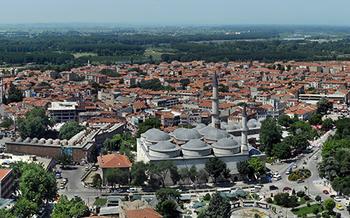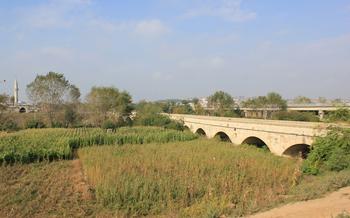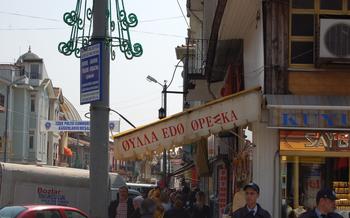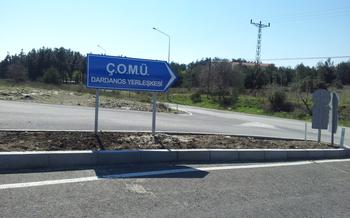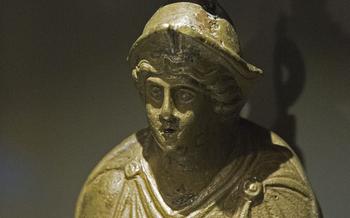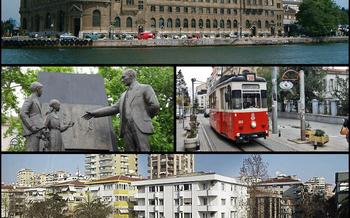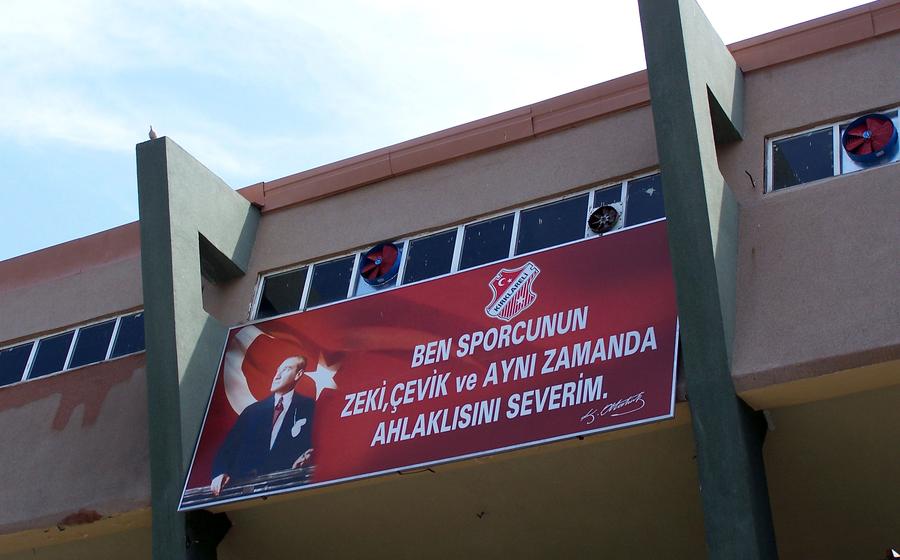
Kırklareli Historical Railway Station
- Kırklareli Historical Railway Station: A Journey Through Time
- Exploring the Museum's Exhibits
- Stepping into the Station Master's Office
- Exploring the Waiting Rooms
- The Station's Role in Trade and Commerce
- Witnessing the Arrival of the Orient Express
- The Station's Role in World War I
- The Station's Transformation into a Museum
- Unveiling the Stories of Station Staff
- Exploring the Station's Environs
- Tips for Planning Your Visit
- Capturing the Essence of the Station
- Engaging with Local Culture
- Unforgettable Experiences at the Station
- Insider Tip: Hidden Gems
Kırklareli Historical Railway Station: A Journey Through Time
The Kırklareli Historical Railway Station, a testament to the region's rich history, stands as a majestic relic of the Ottoman Empire. Constructed during the late 19th century, it served as a crucial hub connecting Istanbul to Europe and beyond, playing a pivotal role in trade, transportation, and cultural exchange. Its unique architectural blend of Ottoman and European styles reflects the convergence of cultures that shaped this vibrant region. Today, meticulously restored and transformed into a museum, the station offers visitors a captivating journey through time, immersing them in the grandeur and significance of this bygone era.
Exploring the Museum's Exhibits
The museum at Kırklareli Historical Railway Station houses a fascinating collection of artifacts, photographs, documents, and interactive displays that bring the station's rich history to life. Among the artifacts on display are vintage train tickets, signal lamps, uniforms, and tools used by railway workers. Captivating photographs depict the station's golden era, showcasing the bustling atmosphere and the diverse travelers who passed through its doors. Historical documents, such as timetables, records, and correspondence, provide insights into the station's operations and management. Interactive exhibits, including touchscreens and multimedia presentations, allow visitors to engage with the station's history in a dynamic and immersive way, making the museum an educational and entertaining experience for visitors of all ages.
Stepping into the Station Master's Office
The station master's office, located at the heart of the Kırklareli Historical Railway Station, offers a glimpse into the crucial role these individuals played in managing train operations. Their responsibilities encompassed ensuring the smooth running of trains, coordinating schedules, and maintaining communication with other stations along the line.
Artifacts on display in the office, such as personal belongings and documents, shed light on their daily duties and the challenges they faced. Visitors can examine uniforms, meticulously preserved in glass cases, that reflect the station masters' professional standing and authority.
The office also features exhibits showcasing the communication methods used to coordinate train movements. These include vintage telephones, telegraph machines, and signal lamps, providing insights into the intricate network of communication that ensured the safe and efficient operation of trains.
Exploring the Waiting Rooms
The Kırklareli Historical Railway Station featured three distinct waiting rooms, each catering to different classes of passengers: first-class, second-class, and third-class.
-
First-class lounge: The first-class waiting room was the epitome of opulence and luxury. Reserved for elite travelers, it boasted plush furnishings, elegant chandeliers, and intricate decorations. Passengers could relax in comfortable armchairs, read newspapers, or enjoy refreshments while waiting for their train.
-
Second-class lounge: The second-class waiting room offered a more modest yet comfortable ambiance. It featured wooden benches, simpler decorations, and a smaller selection of amenities. Second-class passengers could still enjoy the convenience of a waiting room while traveling on a budget.
-
Third-class lounge: The third-class waiting room was the most basic of the three. It provided simple benches for passengers to rest on and a few hooks for hanging luggage. While it lacked the luxuries of the other waiting rooms, it offered a functional space for third-class passengers to wait for their trains.
Despite their differences, all three waiting rooms were decorated with intricate details and furnishings that reflected the station's rich history and cultural heritage. These waiting rooms offer a glimpse into the diverse social classes that traveled through the station, from wealthy merchants and diplomats to ordinary farmers and laborers.
The Station's Role in Trade and Commerce
The Kırklareli Historical Railway Station played a pivotal role in the economic development of the region. As a crucial transportation hub, the station facilitated the efficient movement of agricultural products from Thrace to major cities, fostering trade and commerce. The fertile lands of Thrace produced an abundance of crops, including wheat, barley, and tobacco, which were transported by train to markets across the country.
The station also supported the growth of industries in Kırklareli. Local businesses relied on the railway to transport raw materials and finished goods, contributing to the city's economic prosperity. The station's strategic location on the main railway line connecting Istanbul to Europe made it an ideal gateway for international trade. Merchants from neighboring countries, such as Bulgaria and Greece, utilized the station to import and export goods, fostering cultural exchange and economic cooperation.
Overall, the Kırklareli Historical Railway Station served as a catalyst for economic growth and development in the region. Its role in facilitating trade and commerce transformed Kırklareli into a thriving commercial center, connecting it to markets both domestically and internationally.
Witnessing the Arrival of the Orient Express
Amidst the clamor of the bustling station, a legendary train pulled to a stop, its arrival heralding an era of glamour and intrigue. The Orient Express, a symbol of luxury and adventure, connected Istanbul to Paris, traversing borders and cultures. Passengers from all walks of life graced the Kırklareli platform, from diplomats and dignitaries to celebrities and adventurers. The station witnessed the exchange of passports and the meticulous inspection of luggage as travelers prepared to cross international borders. It was a time of excitement, anticipation, and cultural exchange, as people from different backgrounds mingled and shared stories. The Orient Express not only transported passengers but also carried with it the essence of diverse cultures, connecting the East and the West in a journey that transcended mere travel.
The Station's Role in World War I
During World War I, the Kırklareli Historical Railway Station played a crucial strategic role as a military hub. As the Ottoman Empire fought on multiple fronts, the station served as a vital transportation center for troops and supplies to and from the front lines. Thousands of soldiers passed through the station, embarking on their journeys to defend their homeland.
The station also facilitated the delivery of international aid during the war. Humanitarian organizations utilized the railway to transport food, medical supplies, and other essential goods to communities affected by the conflict. The station became a lifeline for those in need, helping to alleviate suffering and provide support during a time of great hardship.
In the aftermath of the war, the station played a significant role in the reconstruction efforts. The transportation of building materials, equipment, and personnel through the station was essential for rebuilding infrastructure, restoring livelihoods, and healing the wounds of war.
Despite the challenges and devastation of the war, the Kırklareli Historical Railway Station remained a symbol of resilience and hope. Its role in supporting the war effort and facilitating post-war reconstruction underscores its enduring significance as a transportation hub and a testament to the unyielding spirit of the Turkish people.
The Station's Transformation into a Museum
Preserving the rich heritage of the Kırklareli Historical Railway Station, meticulous efforts were undertaken to transform it into a museum. Recognizing the station's cultural and historical significance, local authorities and preservationists collaborated to restore and repurpose the building.
The restoration process involved careful attention to detail, ensuring that the station's architectural integrity and original features were maintained. Skilled artisans and craftsmen worked diligently to repair and restore the station's intricate details, from the ornate tilework to the wooden ceiling beams.
The curatorial vision behind the museum aimed to create an immersive and engaging experience for visitors. The exhibits were carefully curated to showcase the station's history, artifacts, and stories, providing a comprehensive narrative of its past.
The transformation of the station into a museum has not only preserved its legacy but also transformed it into a vibrant cultural hub. It serves as a testament to the region's rich history and heritage, while also promoting cultural exchange and education.
Unveiling the Stories of Station Staff
The Kırklareli Historical Railway Station is not merely a museum of artifacts and exhibits; it is also a repository of captivating stories shared by former station employees and their families. Through oral histories and personal anecdotes, visitors can gain a glimpse into the challenges, joys, and camaraderie experienced by the station's staff.
Listen to the tales of station masters who meticulously managed train operations, ensuring the safe and efficient movement of passengers and goods. Discover the behind-the-scenes insights of ticket agents, porters, and engineers who worked tirelessly to keep the station running smoothly.
Learn about the friendships and rivalries that developed among the station staff, as well as the bonds they formed with the passengers who frequented the station. These personal narratives offer a unique perspective on the human side of railway history, showcasing the dedication and passion of the individuals who made the station a vibrant hub of activity.
Preserving these stories is of utmost importance, as they form an integral part of the station's legacy. By capturing and sharing these firsthand accounts, the museum ensures that the memories and experiences of the station's staff live on, providing visitors with a deeper understanding of the human dimension of railway history.
Exploring the Station's Environs
Beyond the walls of the Kırklareli Historical Railway Station lies a wealth of experiences waiting to be discovered. Immerse yourself in the vibrant culture and stunning natural beauty of the surrounding area. Indulge in the delectable flavors of local cuisine, from traditional Turkish dishes to regional specialties that tantalize the taste buds.
Explore nearby historical landmarks, such as the imposing Kırklareli Castle, a testament to the region's rich past. Marvel at the architectural grandeur of the Rusçuk Mustafa Pasha Mosque, a sacred space that invites contemplation and serenity.
Escape into the embrace of nature as you venture into the surrounding forests, where towering trees create a symphony of rustling leaves. Follow the meandering rivers that cut through the landscape, their gentle currents whispering secrets of the land. Stroll along the shores of the Black Sea, where the waves caress the sandy beaches, inviting you to lose yourself in the vastness of the horizon.
Embrace the vibrant arts scene that thrives in Kırklareli. Attend local festivals that showcase the region's rich cultural heritage, where music, dance, and traditional crafts come alive. Visit museums that house treasures from the past, telling stories of the people and events that shaped this remarkable land.
As you explore the environs of the Kırklareli Historical Railway Station, you'll discover a tapestry of experiences that blend history, nature, and culture. Let the spirit of discovery guide you as you create unforgettable memories in this enchanting region.
Tips for Planning Your Visit
Before embarking on your journey to the Kırklareli Historical Railway Station, it's essential to plan ahead to ensure a smooth and memorable experience. Here are some practical tips to help you make the most of your visit:
Check the opening hours: The museum's operating hours may vary depending on the season, so it's advisable to check their official website or contact them directly to confirm the current hours of operation. This will help you avoid disappointment and ensure that you have ample time to explore the station's exhibits and surroundings.
Consider booking a guided tour: Guided tours are an excellent way to delve deeper into the station's history, architecture, and significance. Knowledgeable guides can provide fascinating insights and anecdotes that bring the station's past to life, enriching your overall experience.
Remember your camera: The Kırklareli Historical Railway Station is a visual feast, with its intricate architectural details, historical artifacts, and captivating exhibits. Don't forget to bring your camera to capture the station's beauty and preserve your memories for years to come.
Inquire about accessibility options: The museum is committed to ensuring that all visitors have an enjoyable and inclusive experience. If you have any accessibility requirements or concerns, don't hesitate to inquire about available options. The museum staff is dedicated to providing assistance and making necessary arrangements to accommodate your needs.
Capturing the Essence of the Station
Capturing the Essence of the Station
As you explore the Kırklareli Historical Railway Station, don't forget to bring your camera to capture its architectural grandeur and the storytelling potential of its exhibits. Experiment with different angles and perspectives to showcase the station's unique features, from the intricate details of its facade to the atmospheric interiors.
Share your photographs on social media platforms, along with captivating stories and anecdotes about the station's history and significance. Use hashtags related to travel, history, and architecture to reach a wider audience and inspire others to visit this hidden gem.
The station's unique atmosphere can serve as a source of inspiration for creative expression. Whether you're a photographer, writer, or filmmaker, let the station's rich heritage and captivating stories spark your imagination. Capture the essence of this historic landmark through your art, sharing your unique perspective with the world.
Photography Tips:
- Use a tripod to ensure sharp images, especially in low-light conditions.
- Experiment with different shutter speeds to capture the movement of trains or people.
- Pay attention to the lighting, as the station's interior and exterior change throughout the day.
- Look for interesting details and compositions, such as reflections in the station's windows or patterns in the tiles.
- Don't be afraid to experiment with different editing techniques to enhance your photographs.
Engaging with Local Culture
Immersing yourself in the local culture is an essential part of any travel experience. When visiting the Kırklareli Historical Railway Station, take the opportunity to connect with the friendly locals and embrace their unique customs and traditions. Learning a few basic Turkish phrases, such as "Merhaba" (hello) and "Teşekkür ederim" (thank you), will go a long way in showing respect and breaking the ice.
Familiarize yourself with local customs and traditions to avoid misunderstandings and show respect. For example, it is customary to remove your shoes when entering a mosque or a home. When in doubt, observe how locals behave and follow their lead. Supporting local businesses is a great way to contribute to the local economy and show your appreciation for the community. Shop at local markets for fresh produce, handmade crafts, and souvenirs, and dine at local restaurants to sample the delicious regional cuisine. This not only supports the local economy but also allows you to engage with the locals and learn about their way of life.
Unforgettable Experiences at the Station
The Kırklareli Historical Railway Station offers a myriad of unforgettable experiences for visitors. Throughout the year, the station hosts special events and exhibitions that delve deeper into its history, culture, and significance. These events often feature live music, historical reenactments, art exhibitions, and educational programs, providing visitors with a unique and immersive experience.
Exploring the station at night is another magical experience. As darkness envelops the station, its architectural details and exhibits take on a new and enchanting aura. The soft glow of lanterns illuminates the station's platform and waiting rooms, creating a nostalgic and atmospheric ambiance.
The changing seasons also bring their own unique charm to the station. In the winter, snow transforms the station into a picturesque winter wonderland, while in the spring, the surrounding gardens burst into bloom, creating a vibrant and colorful display. Summer brings warm evenings perfect for strolling along the station's platform and enjoying the cool breeze.
Finally, the Kırklareli Historical Railway Station is a place where personal connections are forged. Visitors from all walks of life come together to share their love of history, culture, and travel. Engaging in conversations with fellow travelers, learning about their experiences, and sharing stories creates a sense of camaraderie and makes the visit even more memorable.
Insider Tip: Hidden Gems
As you wander through the Kırklareli Historical Railway Station, keep an eye out for hidden corners that reveal the station's hidden treasures. Discover secluded nooks that offer stunning views of the surrounding landscape or unique vantage points that showcase architectural details often missed by the casual observer. Engage with locals and ask for their recommendations on hidden gems in Kırklareli. They might suggest charming cafes, local markets, or natural wonders that are off the beaten path. Embrace the tranquility of the off-season, when the station exudes a serene and intimate ambiance, allowing you to connect with its history and essence on a deeper level. Be open to unexpected discoveries as you explore the station's every nook and cranny, creating a truly unforgettable and immersive experience.
